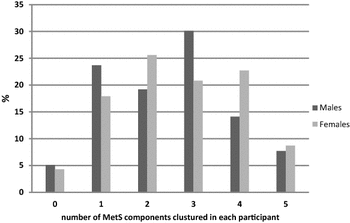Metabolic syndrome among overweight and obese adults in Palestinian refugee camps
- PMID: 29713387
- PMCID: PMC5907715
- DOI: 10.1186/s13098-018-0337-2
Metabolic syndrome among overweight and obese adults in Palestinian refugee camps
Abstract
Background: Metabolic syndrome (MetS) is one of the main reasons for elevated cardiovascular morbidity and mortality worldwide. Obese and overweight individuals are at high risk of developing these chronic diseases. The aim of this study was to characterize and establish sex-adjusted prevalence of metabolic syndrome and its components.
Methods: A cross-sectional study was conducted in 2015, 689 (329 men and 360 women) aged 18-65 years from three refugee camps in the West Bank. International Diabetes Federation and modified National Cholesterol Education Program-Third Adult Treatment Panel definitions were used to identify MetS.
Results: The overall prevalence of obesity and overweight was high, 63.1%; Obesity (42 and 29.2% in women men; respectively and overweight 25.8 and 28.9% in women and men; respectively. The prevalence of MetS among obese and overweight was significantly higher (69.4%) according to IDF than NCEP definition (52%) (p < 0.002) with no significant differences between men and women using both definitions; (IDF; 71.8% men vs. 67.6% women, and (NCEP/ATP III; 51.9% men vs. 52.2% women). The prevalence of MetS increased significantly with increasing obesity and age when NCEP criterion is applied but not IDF. The prevalence of individual MetS components was: high waist circumference 81.3% according to IDF and 56.5% according to NCEP, elevated FBS 65.3% according to IDF and 56% according to NCEP, elevated blood pressure 48%, decreased HDL 65.8%, and elevated triglycerides 31.7%. Based on gender differences, waist circumferences were significantly higher in women according to both criteria and only elevated FBS was higher in women according to IDF criteria. Physical activity was inversely associated with MetS prevalence according to NCEP but not IDF. No significant associations were found with gender, smoking, TV watching, and family history of hypertension or diabetes mellitus.
Conclusion: In this study, irrespective of the definition used, metabolic syndrome is highly prevalent in obese and overweight Palestinian adults with no gender-based differences. The contribution of the metabolic components to the metabolic syndrome is different in men and women. With the increase of age and obesity, the clustering of metabolic syndrome components increased remarkably. More attention through health care providers should, therefore, be given to the adult population at risk to reduce adulthood obesity and subsequent cardiovascular diseases.
Keywords: Adults; Metabolic syndrome; Obesity and overweight.
Figures

Similar articles
-
The reliability of the National Cholesterol Education Program's Adult Treatment Panel III (NCEP/ATP III) and the International Diabetes Federation (IDF) definitions in diagnosing metabolic syndrome (MetS) among Gaza Strip Palestinians.Diabetes Metab Syndr. 2012 Jan-Mar;6(1):4-8. doi: 10.1016/j.dsx.2012.05.017. Epub 2012 Jun 7. Diabetes Metab Syndr. 2012. PMID: 23014247 Clinical Trial.
-
Characterization and prevalence of metabolic syndrome among overweight and obese young Palestinian students at An-Najah National University.Diabetes Metab Syndr. 2018 May;12(3):343-348. doi: 10.1016/j.dsx.2017.12.021. Epub 2017 Dec 30. Diabetes Metab Syndr. 2018. PMID: 29306543
-
Prevalence of Metabolic Syndrome among Malaysians using the International Diabetes Federation, National Cholesterol Education Program and Modified World Health Organization Definitions.Malays J Nutr. 2008 Mar;14(1):65-77. Epub 2008 Mar 15. Malays J Nutr. 2008. PMID: 22691765
-
Prognostic interactions between cardiovascular risk factors.Dan Med J. 2014 Jul;61(7):B4892. Dan Med J. 2014. PMID: 25123126 Review.
-
Prevalence of Metabolic Syndrome and Its Components in the Iranian Adult Population: A Systematic Review and Meta-Analysis.Iran Red Crescent Med J. 2015 Dec 27;17(12):e24723. doi: 10.5812/ircmj.24723. eCollection 2015 Dec. Iran Red Crescent Med J. 2015. PMID: 26756015 Free PMC article. Review.
Cited by
-
Risk of metabolic syndrome linked to tobacco smoking and caffeine consumption among Palestinian university students.Cent Eur J Public Health. 2024 Dec;32(4):243-250. doi: 10.21101/cejph.a7320. Cent Eur J Public Health. 2024. PMID: 39903594
-
Role of food aid and assistance in addressing the double burden of malnutrition in Ghana: a qualitative policy analysis.BMJ Nutr Prev Health. 2020 Sep 12;3(2):196-204. doi: 10.1136/bmjnph-2020-000136. eCollection 2020 Dec. BMJ Nutr Prev Health. 2020. PMID: 33521529 Free PMC article.
-
Eating Disorders and the Use of Cognitive Enhancers and Psychostimulants Among University Students: A Cross-Sectional Study.Neuropsychiatr Dis Treat. 2021 May 25;17:1633-1645. doi: 10.2147/NDT.S308598. eCollection 2021. Neuropsychiatr Dis Treat. 2021. PMID: 34079261 Free PMC article.
-
Age-specific diabetes risk by the number of metabolic syndrome components: a Korean nationwide cohort study.Diabetol Metab Syndr. 2019 Dec 27;11:112. doi: 10.1186/s13098-019-0509-8. eCollection 2019. Diabetol Metab Syndr. 2019. PMID: 31890046 Free PMC article.
-
A systematic review of the burden of, access to services for and perceptions of patients with overweight and obesity, in humanitarian crisis settings.PLoS One. 2023 Apr 24;18(4):e0282823. doi: 10.1371/journal.pone.0282823. eCollection 2023. PLoS One. 2023. PMID: 37093795 Free PMC article.
References
-
- Alberti KG, Zimmet PZ. Definition, diagnosis and classification of diabetes mellitus and its complications. Part 1: diagnosis and classification of diabetes mellitus provisional report of a WHO consultation. Diabetic Med J Br Diabetic Assoc. 1998;15(7):539–553. - PubMed
-
- Ford ES, Giles WH, Dietz WH. Prevalence of the metabolic syndrome among US adults. JAMA. 2002;287:356–359. - PubMed
-
- Third Report of the National Cholesterol Education Program (NCEP) expert panel on detection, evaluation, and treatment of high blood cholesterol in adults (Adult Treatment Panel III) final report. Circulation. 2002; 106(25):3143–421. - PubMed
-
- Alberti KG, Zimmet P, Shaw J. The metabolic syndrome—a new worldwide definition. Lancet (London, England) 2005;366(9491):1059–1062. - PubMed
LinkOut - more resources
Full Text Sources
Other Literature Sources

